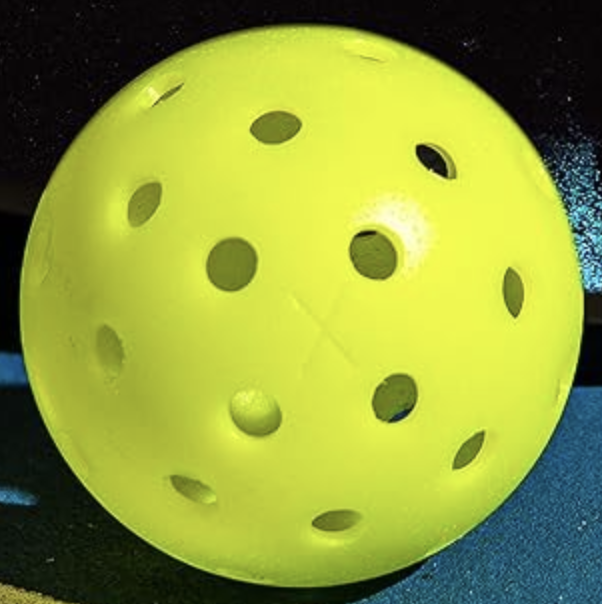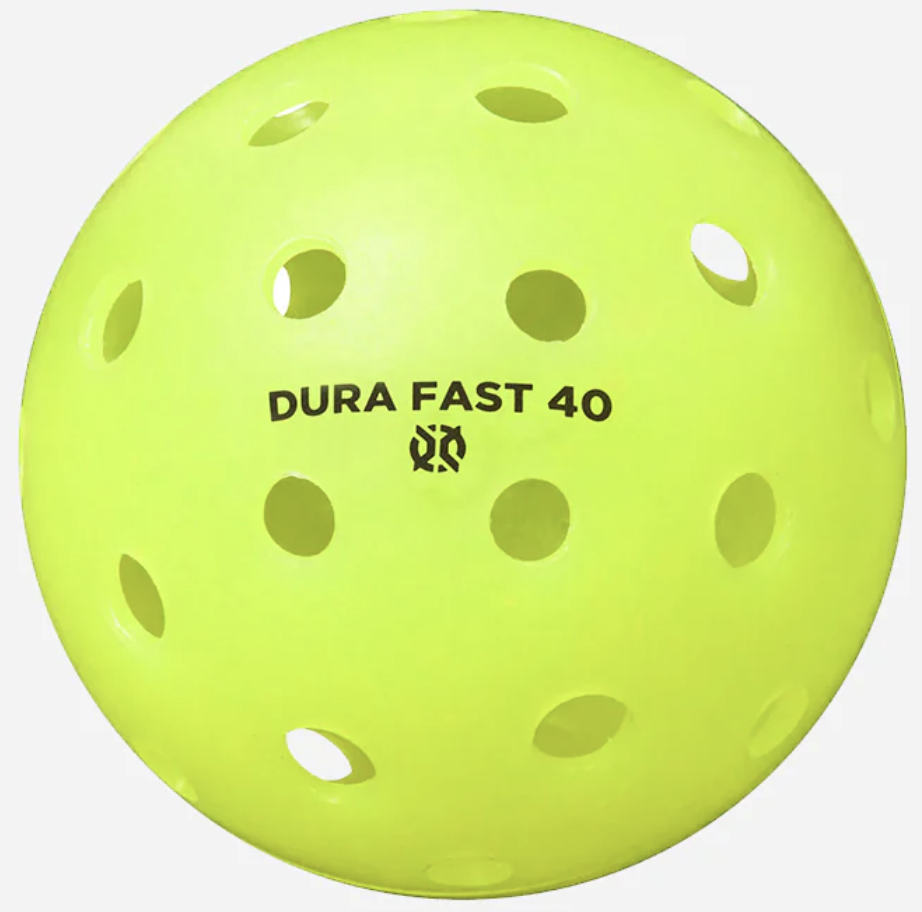new year, new balls?
Let’s talk about pickleballs.
Many first-time players who purchase a paddle bundle online will receive some pickleballs for free. While these balls are completely fine for anyone just starting to play, the reality is that if you’re planning on playing with people outside of your annual family tournaments, you’re going to need to get to know some other balls.
You won’t be using these balls (or paddles) for very long
The two primary balls you will see at most facilities and open plays will be either the Franklin X-40 or the Onix Durafast 40. The differences between the two balls can be broken down into a few categories: Price, speed, durability, temperature impact, and ubiquity. I will break down each factor and name the winner of each category.
Price:
Balls typically come in packs of 3, 12, 24, or 100. The more balls you buy, the cheaper the price per ball will be. Depending on the quantity you purchase, X-40s can range from $2.00-$3 per ball, and Duras can be $3-$4 per ball. We have a 10% discount code from justpaddles.com that brings a pack of 100 X-40s balls to $2.00 per ball.
Winner: Franklin X-40
Speed:
Some of the most exciting parts of pickleball are the fast-paced hand battles. If you’re looking for a ball that encourages that style of play, the Durafast 40 is the ball of choice.
Winner: Durafast 40
Durability:
Sadly, plastic balls are not indestructible and eventually pickleballs crack or break. The harder plastic of the dura that makes them fast, also makes them more prone to cracking or getting small dents on the surface, something we call “going out of round”. These dents on the surface can often create challenging bounces, especially on fast-paced serves and shots with spin. Duras can develop “microcracks” around the holes, which do not severely impact the play of the ball, but will eventually lead to larger cracks.
Franklin balls are a different material and can last longer than a Dura, but when they eventually do crack, they are unusable.
Winner: Franklin X-40
Temperature Impact:
As NYCers, we are conditioned to play pickleball in a wide range of temperatures and conditions. Both high and low temperatures impact the playability of each ball significantly. In the heat, a Franklin ball which is already slower to begin with will begin to feel “soft and mushy” as many pro players describe it. This makes putting the ball away very difficult and can create extended points. In temperatures below 40 degrees, Franklins tend to crack fairly easily, so it is suggested to keep a rotation of balls in the cold, one in play, and one in someone’s pocket to keep warm.
The Dura will maintain a lot of its speed and playability in the heat, although the ball may deform more in higher temperatures. Once it gets below 45 degrees, you’ll be hard-pressed to get through more than a few games with a Dura depending on how hard you hit.
Winner: Pros and cons of each ball
Ubiquity:
As participation continues to grow and the pickleball skill curve gets wider, there will be a greater distinction between casual players and tournament players. Casual players may naturally be attracted to the Franklin X-40 because of the factors listed above such as price, speed, and durability. Tournament players mainly care about what ball a tournament is using, and up until 2024, the primary tournament ball for both the PPA and APP tournaments has been the Durafast 40. Some smaller local tournaments end up choosing the cheaper x-40 balls, but for players above the 4.5+ level who often have faster reactions and are engaging in faster firefights, the Dura has been the preferred choice.
Winner:
Mass market - Franklin X-40
Tournament players - Durafast 40
This leads me to discuss the big changes coming for 2024:
Two factors may impact what balls you’ll start seeing on the courts next year:
More and more companies are making affordable balls that are finding the balance between a Franklin and a Dura in terms of speed and durability.
Both pro tours are changing their official balls, which may trickle down to the high-level amateur scene.
Newer balls on the market
Over the past few years, there have been several companies coming out with balls meant to compete in the local scene against the Franklin and Dura balls. Core, Oso, Diadem, PCKL among many others have produced balls that are comparable to the main balls on the market. They each have their distinct bounce and speed, so some players used to Franklin or Dura may notice the difference enough to not want to play with them, but I believe they are all very usable.
The ball that I believe could take our local scene by storm is the Selkirk Pro S1. Released in Q4 of 2023, this ball to me feels like a true balance between the Franklin and the Dura. These balls can be acquired for $2.50 or less per ball, so less expensive than the cheapest Dura, and we have not cracked a single one yet, even in outdoor temperatures of below 35 degrees. Selkirk is so confident in their product that they are touting a 1 year no crack warranty*.
The one gripe some players have had is that the ball seems to go out of round after a few games, which is similar to a Dura. My response to this is that these are plastic balls and there will never be an uncrackable, nondeforming ball, in the neon color that people prefer, that are also affordable. (Wilson produces a very well-constructed ball that is known to not crack or deform, but the color is red which people may not be used to)
Changing pro scene
The primary ball for the pro tours over the past several years has been the Onix Durafast 40. Most of the amateur divisions of these tournaments would also use the Dura, which meant that anyone who wanted to practice for those tournaments would end up playing with those balls. With the contract between the pro tours and Onix ending this year, both tours are heading in different directions.
PPA
The PPA tour is going to be using a ball made by Vulcan- The Vulcan Pro Flight. They are now publicly available but have an MSRP of around $4 per ball which feels like a significant jump. Our early play test seems to indicate that they last longer than a Dura, but are slower and still get out of round. While many people are balking at the price, the counter argument is that if you were willing to pay $3 for a ball that would crack after two games, then paying $4 shouldn’t be an issue if the ball lasts twice as long (or longer).
APP
The APP tour is going to us a ball made by the Owl Sport, the creators of USAP’s first approved paddle for the quiet category. This new partnership with Owl makes sense as USAP and the APP have always been close entities, and USAP is making a big push to helping the sport grow by solving the noise problem. This ball is not itself part of the quiet category, so I don’t expect it to be much different than other balls we’ve seen in the market. Likely somewhere between an X-40 and a Dura. It may end up feeling a bit too slow for many pros, but the evolving speed of the game can be saved for an entirely separate blog post.
In summary, the ball market is more fragmented than ever. I believe that Franklin X-40s will continue to be the primary ball seen on public courts and casual pickleball facilities. However, in colder areas, I can see the Selkirk Pro S1 becoming a popular alternative that could have staying power even when the weather warms up.
In pickleball-focused facilities that are catering towards the more serious, higher-level players, we could start seeing buckets of Vulcans and Owl balls there, as players want to get the sense that they are playing to the pro standards. We’ll see how the pros react to the new balls as the first tournament gets underway this weekend.





